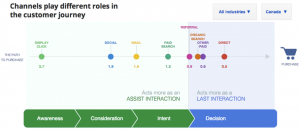Columnist Aaron Strout sits down with GasBuddy’s Mike Schneider to discuss which companies are doing location-based services right and what’s ahead for the industry.

Five years ago, my co-author, Mike Schneider, and I published one of the first books ever written on the topic of location-based marketing.
At the time, all the buzz focused on active check-in apps like Foursquare, Gowalla, Whrrl and SCVNGR. Today, only Foursquare still exists (although SCVNGR has morphed into location-based payments service LevelUp), and it has become much more like Yelp and much less an active check-in service.
A lot has changed over the last five years. Location-based services (LBS) have mainly become a feature, and LBS is more a passive sport than an active one. For the most part, all of the major social networks have adopted location-based features in a meaningful way. And yet we are still only scratching the surface of what’s possible.
I recently took the time to talk to Schneider about a new role he recently took at a company that is employing crowdsourced location data and is helping consumers use that information to save money. In addition, we discussed who else is doing location-based services well, who isn’t and where the industry is headed.
What follows is an edited transcript of our conversation.

GasBuddy’s Mike Schneider
Q: You recently took a new role at a company called GasBuddy. Can you tell us a little bit about your role and the company?
Schneider: GasBuddy is one of the earliest users of crowdsourcing. Founders Jason Toews and Dustin Coupal recognized that gas prices are volatile and that people love to talk about them. They built a series of websites designed to help consumers help each other find the best price on gas.
The GasBuddy app has been downloaded more than 52 million times, and consumers literally help one another save billions per year. My role is to be the chief evangelist for the user experience, to guide the brand to great heights while fostering growth.
Q: Talk a little bit more about how companies are leveraging the marriage of location data and exposing that data via APIs.
Schneider: Most of the useful location data I’m seeing is being exposed through digital management platforms (DMPs) and demand-side platforms (DSPs). Oracle Marketing Cloud, for instance, is aggregating location data and adding it to other contextual data to improve targeting. Factual is doing something similar.
If you want to talk about harnessing the power of your data in an app, it’s still pretty hard to do with an API (application program interface). There are a few companies out there that provide software developer kits (SDKs) with geo-fencing and contextual personas that let you trigger events or capture user behavior to do things beyond the ad: Skyhook (which invented hybrid positioning), Location Kit, ArcGIS and Wireless Registry.
There’s also proximity, which is a form of location that defines an even more precise area. Most people think about beacons from companies like Footmarks, Gimbal and Roximity.
Data listing companies like Yext are in the beacons game, too. Yext could unlock the promise of beacons — having context attached to a beacon.
Q: As my fellow author for “Location-Based Marketing for Dummies,” you spend a lot of time thinking about the space. What else are you seeing around you?
Schneider: The Internet of Things is getting serious. There are a bunch of companies trying to make beacons useful for consumers.
Tile is one that helps you find your keys or phone. Pixie is another one that lets you put beacons on things and then makes your phone into a virtual reality viewfinder.
Consumer technology is getting smarter, and the connected home promise is getting stronger because now, not only can you talk to the dryer and the refrigerator through your phone, you can manage your sprinkler system, your thermostat, the smoke and carbon monoxide alarms and your in-home security cameras.
Everything is managed through the phone, even your holiday lights. It’s not all done through one dashboard, however, so the one-stop command center is a ways off.
Q: What two to three other companies are you impressed with?
Schneider: I love how Weft is taking on global logistics and using location to help businesses make smarter supply-chain decisions.
As a marketer, I am focused on companies that are helping me drive decisions. Localytics drives user experience decisions by showing us the data in interaction paths. It uses location to help give a breakdown of where my users are across the globe. Hubspot does this on the B2B side.
I am still intrigued by companies that let us get closer than 50-meter precision. Have you seen what Indoor Atlas is doing? They describe it as “locate people or objects inside a building using radio waves, magnetic fields, acoustic signals, or other sensory information collected by a smartphone device or tablet. These systems are used to detect and track a position. Just think of it as GPS, but for indoors.”
Q: What’s disappointed you over the last 12 months — i.e., you expected to see grow faster?
Schneider: We still don’t have the best location signals in mobile. The understanding of location is still very high-level.
We still need a lot of education about centroid location versus on-device location. I also want to see more marketers and designers thinking about the best way to ask for location services to be enabled. It is going to take time.
We also do not have context and proximity properly connected. Companies have to create their own contextual solutions to tie data to proximity.
In other words, the inventory in the aisle does not magically appear just because you put a beacon there. I have not seen any companies focused specifically on the standardized data constructs.
My Uber driver still has a really hard time finding me. I keep wondering if they will try to get a better handle on location. They still rely on the operating system to provide it when it’s arguably the most important part of their business.
They also give a lot of data to Google and Apple, who both are reportedly working on self-driving cars.
Q: Is the active check-in dead?
Schneider: The short answer is “yes.” But there are better ways to say: “I’m here,” like reporting the prices at the gas pump or taking a picture and attaching location. Swarm is still kicking, but Foursquare is now clearly using passive check-ins.
Q: How can companies like Facebook and Twitter use location more strategically?
Schneider: These two both have enough location signals at scale to do really cool things. Focus is the key — and realization that there’s a lot they can do with the signals they have. I think they are both very focused on how to monetize using location and are using it for ad and content targeting.
Q: If you are a marketer at a B2B company, are location-based technologies relevant?
Schneider: People are people. They go places; they have personalities. The more you can learn about your target audience, the better content you can put in front of them.
It is a lot less important for B2B, where much of the selling is done through partnerships and relationships, than for B2C.
B2B companies are using LBS to manage their businesses. Look at FreightFarms, for instance. The location of the farm is one of the data points they use to monitor the production. Xively is powering that platform.
Location is one powerful data point in the Internet of Things. The device does not need to move for location to be relevant. Location can be used for service calls or to ensure that the thing is in the place that it is supposed to be.
Q: Do you think there will be any big news breaking at SXSW this year in the mobile space?
Schneider: I really hope that Franklin BBQ introduces an app that can send me pulled pork and brisket, because I will not be there this year.
The most exciting space this year seems to be health and fitness. There’s been a lot of hype with exercise apparel companies making big bets on technology. The latest of these was Asics’ acquisition of Boston-based RunKeeper.
If I could go to one non-POTUS keynote, it would be Kevin Plank of Under Armour [which acquired the MyFitnessPal and Endomondo apps/sites last year]. I think we are going to see a lot of companies making big bets on the marriage of location, health and apparel at SXSW. Wearables go mainstream!
Q: Where will LBS be in 10 years?
Schneider: We won’t be talking about LBS in 10 years. It will all be wrapped into our fully connected homes and autos — although I hope my car can fly by then.
Proximity experiences will be garden-variety in 10 years. We will just expect that GasBuddy can automatically tell us when the car needs fuel — or even drive it to fuel up on its own so we can take a nap.
Some opinions expressed in this article may be those of a guest author and not necessarily Marketing Land. Staff authors are listed here.








